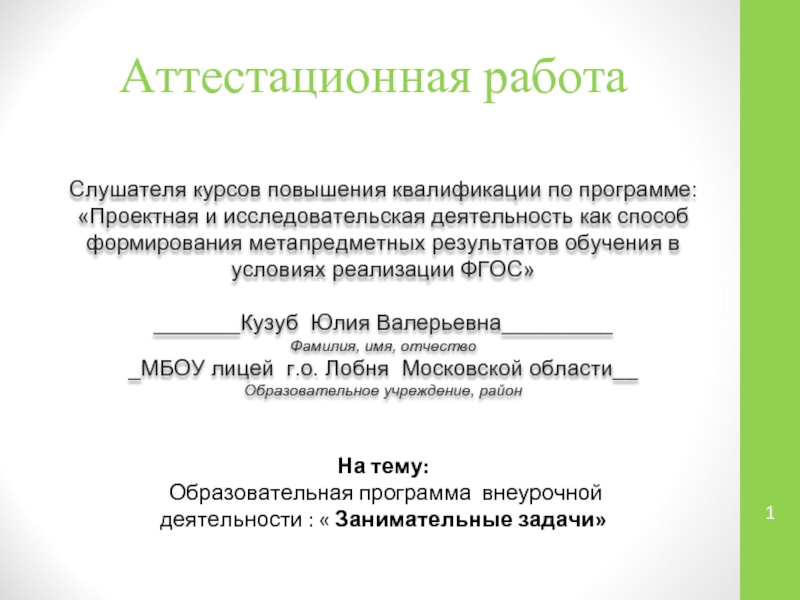- Главная
- Разное
- Дизайн
- Бизнес и предпринимательство
- Аналитика
- Образование
- Развлечения
- Красота и здоровье
- Финансы
- Государство
- Путешествия
- Спорт
- Недвижимость
- Армия
- Графика
- Культурология
- Еда и кулинария
- Лингвистика
- Английский язык
- Астрономия
- Алгебра
- Биология
- География
- Детские презентации
- Информатика
- История
- Литература
- Маркетинг
- Математика
- Медицина
- Менеджмент
- Музыка
- МХК
- Немецкий язык
- ОБЖ
- Обществознание
- Окружающий мир
- Педагогика
- Русский язык
- Технология
- Физика
- Философия
- Химия
- Шаблоны, картинки для презентаций
- Экология
- Экономика
- Юриспруденция
Trigonometry. Angles add to 180° презентация
Содержание
- 1. Trigonometry. Angles add to 180°
- 2. Angles add to 180° The angles of a triangle always add up to 180°
- 3. Right triangles We only care about right
- 4. Example. Solve the equations: a) cos
- 5. The Pythagorean Theorem If you square the
- 6. 5-12-13 There are few triangles with integer
- 7. Ratios Since a triangle has three sides,
- 8. Example. Solve the equations: cos (4x)
- 9. Using the ratios With these functions, if
- 10. Solve equations: а) cos(x/5)=1 The
- 11. Decision: A) This time we proceed
- 12. The hard part If you understood this
- 13. The End
Слайд 3Right triangles
We only care about right triangles
A right triangle is one
Here’s a right triangle:
We call the longest side the hypotenuse
We pick one of the other angles--not the right angle
We name the other two sides relative to that angle
Here’s the
right angle
hypotenuse
adjacent
opposite
Слайд 4Example.
Solve the equations:
a) cos (x / 5) = 1
Decision:
Then x / 5 = πk => x = 5πk The answer is: x = 5πk, where k is an integer.
b) tg (3x-π / 3) = √3
B) We write in the form: 3x-π / 3 = arctg (√3) + πk. We know that: arctg (√3) = π / 3 3x-π / 3 = π / 3 + πk => 3x = 2π / 3 + πk => x = 2π / 9 + πk / 3 The answer is: x = 2π / 9 + πk / 3, where k is an integer.
Слайд 5The Pythagorean Theorem
If you square the length of the two shorter
adj2 + opp2 = hyp2
32 + 42 = 52, or 9 + 16 = 25
hyp = sqrt(adj2 + opp2)
5 = sqrt(9 + 16)
Слайд 65-12-13
There are few triangles with integer sides that satisfy the Pythagorean
3-4-5 and its multiples (6-8-10, etc.) are the best known
5-12-13 and its multiples form another set
25 + 144 = 169
Слайд 7Ratios
Since a triangle has three sides, there are six ways to
Each of these six ratios has a name (and an abbreviation)
Three ratios are most used:
sine = sin = opp / hyp
cosine = cos = adj / hyp
tangent = tan = opp / adj
The other three ratios are redundant with these and can be ignored
The ratios depend on the shape of the triangle (the angles) but not on the size
Слайд 8Example.
Solve the equations:
cos (4x) = √2 / 2.
And find
Decision: Let us solve our equation in general form: 4x = ± arccos (√2 / 2) + 2πk 4x = ± π / 4 + 2πk;
X = ± π / 16 + πk / 2;
Now let's see what roots get into our segment.
When k <0, the solution is also less than zero, we do not fall into our segment.
For k = 0, x = π / 16, we are in the given interval [0; Π].
For k = 1, x = π / 16 + π / 2 = 9π / 16, again we have got.
For k = 2, x = π / 16 + π = 17π / 16, and here we are no longer there, and therefore for large k we also will not fall.
The answer is: x = π / 16, x = 9π / 16
Слайд 9Using the ratios
With these functions, if you know an angle (in
If you know the angle marked in red (call it A) and you know the length of the adjacent side, then
tan A = opp / adj, so length of opposite side is given by
opp = adj * tan A
cos A = adj / hyp, so length of hypotenuse is given by
hyp = adj / cos A
Слайд 10
Solve equations:
а) cos(x/5)=1
The answer is: x = 5πk, where k
б)tg(3x- π/3)= √3
The answer is: x = 2π / 9 + πk / 3, where k is an integer.
Слайд 11 Decision: A) This time we proceed directly to the calculation of
x / 5 = ± arccos (1) + 2πk. Then x / 5 = πk => x = 5πk The answer is: x = 5πk, where k is an integer.
B) We write in the form: 3x-π / 3 = arctg (√3) + πk.
We know that:
arctg (√3) = π / 3 3x-π / 3 = π / 3 + πk => 3x = 2π / 3 + πk => x = 2π / 9 + πk / 3
The answer is:
x = 2π / 9 + πk / 3, where k is an integer
Слайд 12The hard part
If you understood this lecture, you’re in great shape
Here’s the part I’ve always found the hardest:
Memorizing the names of the ratios
sin = opp / hyp
cos = adj / hyp
tan = opp / adj


















